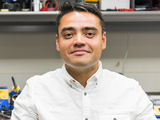Chronicle features UMBC: leading voice in higher ed's future
This story was written by Dinah Winnick and first appeared on news.umbc.edu
A new report from the Chronicle of Higher Education features UMBC’s peer-based work to boost faculty diversity. For decades, UMBC’s strong reputation for inclusive excellence has focused on student diversity. The new UMBC case study in “Diversifying Our Campus: Key Insights and Models for Change” expands that conversation.
The article notes that UMBC received National Science Foundation support to “revamp hiring processes, write more-inclusive job postings, and craft diversity plans for hiring and recruiting” in 2003. This $3.2 million Institutional Transformation Grant sought to promote the recruitment and advancement of women in STEM, and UMBC saw a 70% increase in women tenure-track STEM faculty. At the same time, the university’s recruitment of scholars from underrepresented racial and ethnic groups lagged.
UMBC adopted a new model called STRIDE: Strategies and Tactics for Recruiting to Improve Diversity and Excellence, developed at the University of Michigan at Ann Arbor. A half-dozen faculty now serve as STRIDE fellows, working directly with search committees and departments to improve their processes.
Frank conversations
As the article notes, “fellows have frank conversations with hiring committee members about how to retool their searches.” They bring in competing institutions’ job ads and have hiring committee members critique old UMBC job listings. They also help departments shift gears from recruiting for individual faculty openings to continuously recruiting by building relationships with emerging scholars in their fields.
STRIDE Fellow Nilanjan Banerjee, professor of computer science and electrical engineering, describes in the article how he shared data with his department on the connection between more diverse faculty and greater research funding and productivity. He then helped the department retool their process to advertise positions more widely and dig deeper into the CVs of candidates.
Nilanjan Banerjee (right) works with a student in his lab, 2017.
Seeing results
Autumn Reed, assistant vice provost for faculty affairs, directs the STRIDE program. She notes that initially, “there was a lot of resistance and a lot of skepticism” about STRIDE fellows connecting with hiring committees. But now that departments see other units successfully hiring candidates from underrepresented groups, they want to connect.
Autumn Reed, M.A. ’08, intercultural communication, and Ph.D. ’14, language, literacy, and culture
The article also highlights UMBC’s faculty diversity postdoc programs, through which 12 former fellows have been converted into tenure-track faculty members at UMBC.
Keisha McIntosh Allen is one of several scholars recruited to UMBC as a postdoctoral fellow for faculty diversity. She is now an assistant professor of education. Her research focuses on how race, culture, and identity influence the educational experiences of Black and Brown youth, including how teachers can engage students through asset-based and humanizing pedagogies.
Together, UMBC’s efforts to hire and retain more racially and ethnically diverse faculty have had an impact. In 2011-12, 9% of tenured and tenure-track faculty were Black, Latinx, or Native American. That increased to 15% in 2020-21.
Student Affairs leadership
Earlier this month, the Chronicle featured Nancy Young, vice president for student affairs, in a virtual roundtable on the Future of Student Affairs. The forum reached a national audience of more than 2,000 registrants.
Viewers were eager to learn about how the COVID-19 pandemic has heightened or made more visible students’ needs for support, particularly students from disadvantaged, underrepresented, and vulnerable communities. The event was designed to “bring together student-affairs leaders to explore how the profession is adapting to new demands and the evolving campus landscape.”
Nancy Young, 2017
Focus on connections
Young shared UMBC’s approach to campus safety during the pandemic and the transition back to more on-campus activities. Speaking more broadly about the future, she shared, “I think that what we’re seeing right now is an acceleration of many trends that were already underway,” whether in online learning, the kinds of careers students are preparing for, or the support they need.
Nancy Young (left), True Grit, and Kate Tracy (right) at UMBC’s COVID-19 testing pilot, July 2020.
At the same time, Young noted, “there are also many things that are going to stay the same, and that people can’t wait to get back to” post-COVID. In particular, she says, students just want to hang out with their friends.
With this in mind, Young and her team have been working closely with student leaders and student groups. They’ve sought to better understand how the university can support students’ work to connect with each other, and to engage first-year students in particular.
Nancy Young (right) with SGA President Mehrshad Devin (left) and Communications Director Calista Ogburn (center) on campus in July 2020.
At a time when we are “no longer able to bump into people in the hallways,” she says, this means there is “more intentionality” and more active listening. And these thoughtful approaches have built lasting connections that will bolster the university community for years to come.
Banner image: Nilanjan Banerjee. All photos by Marlayna Demond ’11 for UMBC.
- Attached Photo for Chronicle features UMBC: leading voice in higher ed's future
- Attached Photo for Chronicle features UMBC: leading voice in higher ed's future
- Attached Photo for Chronicle features UMBC: leading voice in higher ed's future
- Attached Photo for Chronicle features UMBC: leading voice in higher ed's future
- Attached Photo for Chronicle features UMBC: leading voice in higher ed's future
- Attached Photo for Chronicle features UMBC: leading voice in higher ed's future
- Attached Photo for Chronicle features UMBC: leading voice in higher ed's future
- Attached Photo for Chronicle features UMBC: leading voice in higher ed's future
Posted: March 25, 2021, 3:06 PM
